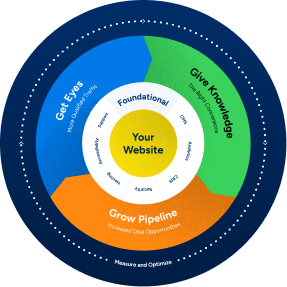For years, the traditional digital marketing approach has always been: get more people to your site and do everything you can until they turn into customers. Sure, you’ll probably see some initial success with this strategy, but more often than not, it won’t get you the results you want, not to mention, you’ll end up spending more money than you should.
Instead, the better approach is to create a full-funnel digital marketing strategy, one that focuses on moving only the best quality leads to the top of your funnel for maximum efficiency.
What Is a Marketing Funnel?
A marketing funnel is a representation of your customer’s journey from prospect to lead to customer to loyal buyer. The journey is shaped like a funnel because it visualizes the number of people, relative to the population, that go through each stage of the customer journey, as described below.
- Awareness – At this stage, your marketing efforts reach out to people who may be interested in your brand.
- Consideration – Here you have people who are now receptive to your marketing messages and are likely to become customers soon.
- Conversion – Your leads have made a purchase.
- Loyalty – Your customers have made repeat purchases.
A full-funnel marketing strategy addresses all of these stages, with specific campaigns focused on goals like lead generation (i.e. consideration stage) and engendering brand loyalty. Here are five ways to create a full-funnel strategy.
1. Don’t Focus on One Stage of the Funnel
As mentioned earlier, it’s important for your digital marketing strategy to touch on different stages of the marketing funnel, nurturing each customer until they reach the loyalty stage.
For example, if your digital marketing efforts have managed to increase your social media likes, but not your sales, you may be focusing too much on the Awareness stage at the expense of the Consideration and Conversion stages. Another problem could be that you’re not really getting a lot of repeat customers, which could mean your Loyalty efforts need a bit of work.
Here are a few examples of tactics you can use at each stage of the marketing funnel.
- Awareness – Content that educates and entertains audiences, making them receptive to future marketing messages
- Consideration – Leverage social proof to help customers when comparing you with your competitors
- Conversion – A promotion that taps FOMO (fear of missing out), such as a limited-time offer
- Loyalty – Loyalty program with exclusive discounts
2. Turn to Your Existing Customers
One mistake many marketers make is settling for the one-off conversion, not knowing that it costs less time and money to get an existing customer to make a repeat purchase than to find more new customers. According to an HBR report, “acquiring a new customer is anywhere from five to 25 times more expensive than retaining an existing one.”
The marketing funnel may be portrayed as a linear journey, but it can be cyclical. For example, a customer who recently purchased a product can be informed of a complementary offering, which puts her back in the Awareness stage once more. With a bit of nurturing, she may end up seriously considering another purchase.
Bottom line? Don’t think of your customers as one-time deals. Retention and upselling go a long way towards maximizing your sales from people who are already familiar with your brand. All that has to be done is to convince them why a repeat purchase is a wise decision.
3. Start and Sustain a Content Marketing Campaign
At the heart of any full-funnel marketing strategy is content. Content is what brings your audience to you. It’s also what makes your brand appear as a thought leader/authority in your industry.
Content is also good for your SEO rankings, which ticks off the Awareness stage. It’s no secret that Google’s core search engine algorithm treats content as a primary ranking factor, provided that content is original, high-quality, and useful to the reader. The higher your search engine rankings are, the more traffic and leads you get to bring to your site.
When creating content, try to take a multichannel approach. Most people think of content marketing as being limited to writing blogs, but that’s only one aspect of it. You can also design branded infographics, upload videos on YouTube, and, of course, share content on your social media channels.
4. Get Sales and Marketing to Work Together
Sales and marketing teams are often at odds with one another. For one, many sales teams view marketing as an expenditure and drain on resources. On the other hand, marketing teams are often frustrated by the fact that sales teams expect instant results from marketing efforts.
Yet despite these opposing views in perspective, sales and marketing teams are actually interdependent. Sales teams are in the best position to get customers’ questions and feedback about your offerings, which marketers can leverage in their communications. Marketing teams, on the other hand, know which leads they can send to sales for conversion.
Getting your sales and marketing teams working together ensures that you have a sales and marketing stack that engages prospects, leads, and existing customers at every stage of the buyer’s journey.
5. Use the Right Tools
Sustaining a full-marketing approach means having to jump from one task to the other and sifting through volumes of marketing metrics. Having the right tools for the job goes a long way towards making things easier, so be sure to have the following at your disposal:
-
- Customer relationship management (CRM) tool – This will compile your customer data and allow your sales team to organize leads forward by marketing.
- Marketing automation tool – This will streamline and automate repetitive tasks such as social media posts, email newsletters, and alerts for task deadlines.
- Data analytics tool – This will provide your teams with the means to track and measure your marketing efforts and identify gaps in your marketing funnel.
Bring It All Together
Effective digital marketing requires a clear strategy that encompasses each stage of the buyer’s journey. It requires reaching out to customers at the right time and place online and guiding them towards becoming your loyal customers. This, of course, can be a huge task for anyone, which is where a reliable digital marketing agency can be of help. Talk to the specialists at GoingClear to formulate a full-funnel strategy for your company.

